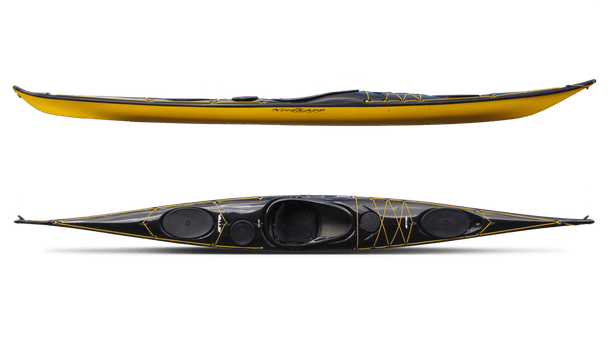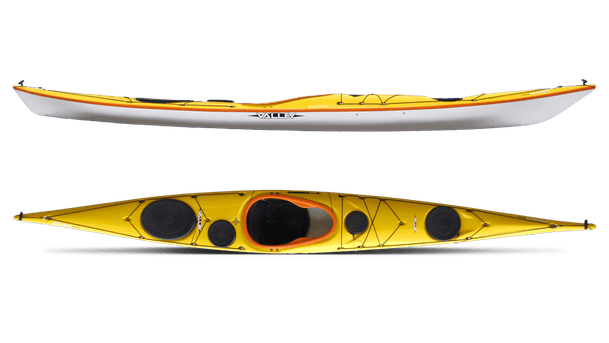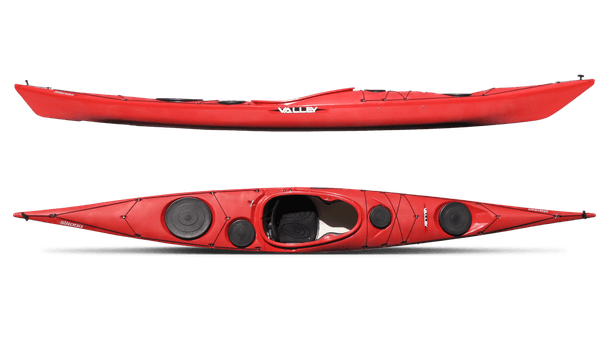- Home
- Gear & Reviews
- Nordkapp H2O
Nordkapp H2O

This Product Has Been Discontinued
More Kayaks from Valley Sea Kayaks:
Nordkapp H2O Description
The Nordkapp H2O is a kayak brought to you by Valley Sea Kayaks. Read Nordkapp H2O reviews or submit your own review to share with the paddling community. Check out a few other kayak recommendations below or explore all kayaks to find the perfect one for you!
Valley Sea Kayaks
Nordkapp H2O Reviews
Read reviews for the Nordkapp H2O by Valley Sea Kayaks as submitted by your fellow paddlers. All of the reviews are created and written by paddlers like you, so be sure to submit your own review and be part of the community!
Mine is a later model in…
It is a fast boat, but don't expect racing boat numbers. The same rocker that gives it remarkable handling also takes away a tad of the velocity. It's designed for real world touring, not the race course. The beam is narrow and tapers quickly to the ends, generating "tippy" and "tender" usage as modifiers in many reviews. It's a paddler's boat. Take command and it responds by handling virtually anything thrown at it. Sitting in it and going along for the ride leads to regrets.
Not a kayak for beginners.
The build quality, hatches, layout of deck lines and skeg operation are all quite good. The outfitting could be better. Toss the seat and build your own out of foam, padding out some knee pockets while you're at it. Mine came with the Henderson foot pump, which I am not wild about. It's easier for me to use a hand variety with good capacity than to extend to reach the foot bulb in pitching seas and keep the boat upright for 60 or so squirts. The pump draws from the forward end of the cockpit so it's a good idea to run a feeder tube to the seat area where the water pools.
The boat rolls easily with the narrow beam and arched deck. While it does extend 18', I wouldn't classify it as a high volume cargo hauler. It's just too narrow and doesn't carry the beam toward the ends. With proper seat location and load distribution, it tracks just fine in the wind.
In spite of the quibbles, I find it an extremely enjoyable kayak to paddle with a rare combination of speed and maneuverability. If you don't mind shouldering the responsibility for stability, it's a touring boat you should test paddle.
I purchased a Nordkapp 18…
Coming from owning SOT Necky's (Spike and Dolphin) and then the Chatham, I felt ready for the next challenge. The Chatham is, without a doubt, one of the finest plastic boats ever. Stable, responsive. Not the fastest but able to keep up with anything. I sat in the Nordkapp on a rough water day to try it. In less than 5 seconds, I noticed that it was a responsive and perhaps "tipsy' boat. Within 30 seconds, I was upside down not sure what the heck just happened. I was in about 1 to 2 foot waves in a little bad weather. Not too challenging, but I was not used to it. The water was rough, with winds at about 25 knots. I paddled the boat stiff and scared. Scared out of my mind. I had the confidence of having taken self rescue classes and was sure I could get back into the boat if needed. I just did not want to get flipped again. I can't roll yet. Yet! With the owner of the boat with me in his other boat, we paddled for about an hour. At times I was thinking "THIS SUCKS!" I want my Chatham! But by the end of the paddle, I realized that the Nordkapp is a boat well designed and a boat I would never outgrow.
It's a boat that challenges you to become a better paddler. I purchased the boat with some hesitation, but I thought I could always sell it if I don't like it. Now, with about 10 additional trips and more hours in the boat, you could offer me twice the cash and I would not sell you my boat. My 18 foot fiberglass Nordkapp is my favorite boat by far. The design of this boat is so that the paddler decides how stable or tipsy it will be. The hull has a smooth round design where you can't really tell initial and secondary stability and it's a matter of muscle memory and experience. I am brazing, edging and playing with the boat more and more.
Now, just under 2 years of kayaking and with a bad case of paddling fever, I am sure my first roll will be in this boat. My longest trips, my most fun adventures and my best kayaking memories will be in my Nordkapp. I look forward to paddling this well designed and beautiful boat for years to come. This boat is a perfect 10.(Maybe a 9 for others with more experience) Anything less would reflect the paddlers preference, but not the boat's quality and features.
A few additional comments…
This is not a "dry" boat; waves run up from behind in following seas, over the bow in head seas and across the deck in beam seas. But that's part of its outstanding rough water performance. It doesn't get tossed around by waves, rather the waves flow past or over it while the kayak remains remarkably steady. (It is disconcerting at the beginning, though.)
The more I paddle the Nordkapp the faster I can make it go. This is especially true in following seas. With concentration, the energy in waves from astern can be harvested with remarkable efficiency. In a following sea no one I know can keep up with me, even quite good paddlers in very good kayaks.
The Nordkapp remains the most seaworthy and fastest kayak I've ever paddled. It is also dramatically unforgiving. There is little static stability. The paddler has to provide the dynamic stability. If you do, the rewards are exceptional.
I enjoy paddling in…
I've got an NDK Romany, an NDK Greenlander Pro, a Valley Anas Acuta, a plastic Wilderness Systems Tempest 170 (for beach bashing) and a Nordkapp H2O. (I used to own an NDK Explorer, but sold it and bought the Nordkapp.)
For rough water paddling, it's a toss up between the Romany and the Nordkapp. The Romany is short (16 feet), maneuverable and forgiving. The Nordkapp is long (18 feet), also maneuverable, but anything but forgiving. In fact, it can be a very demanding kayak.
The Nordkapp is the most responsive kayak I've ever paddled. Precise boat handling is rewarded; badly executed maneuvers are punished. It also has a remarkable "transparency" in rough conditions. By this I mean that steep and confused seas have less effect on the Nordkapp than on any other kayak I have ever paddled. If you are willing to go loose at the hips and let the Nordkapp do the work, it can be paddled steadily through quite ugly conditions, e.g. bad clapotis. While the Romany responds differently, it also handles well in rough conditions. But the Romany (except for a light paddler) is a day boat, while the Nordkapp is a touring boat par excellence.
Another key point is that the Nordkapp is faster than any other boat I have paddled. Faster even than the NDK Greenlander, which deserves its reputation as a fast boat. One final point, I was concerned about the Nordkapp in a following sea. The Romany and the Greenlander surf well. Would the Nordkapp? The Nordkapp has quite a different feel, because the hull shape is soft chined not hard, but it is faster than the others and no less easy to maneuver as long as you can anticipate how it will interact with the waves. Again, it is a demanding, not a forgiving kayak, but remarkably responsive when you get it right.
I was spooked at first by how demanding this kayak could be. I stuck with it. Now, I can say without reservation, this is the best kayak I have ever paddled.
I recently purchased a…
My boat is a Valley Nordkapp,…
I'm 6'5" 205 size 13 feet. The boat is the standard fiberglass.
I've been researching this kayak and a handful of others for the last few years. For all the hype and the history of the boat, it is very hard to get any real insight into it, due to the fact that there has been a number of versions and many, many opinions on the boat, from many sources, most of which have limited exposure to this craft. I spoke to every Valley dealer in the US and only a handful even stock the boat, many have never even seen one. I demoed one in England at the dealer (Knoydart) a couple years back then spoke at length with the importers and a couple of dealers who paddle it on a regular basis. I then went to the Shearwater Kayaks on Orcas Island, San Juans, and paddled my boat at length and in some foul seas and made my decision, before paddling it back to Victoria.
First impressions: Well put together, but with the occasional sloppy gel coating in places, notably the exterior seam. Great deck rigging. Great seat, great back band, highly comfortable and lending to good paddling stance. Given my size this is a snug boat, I have little play and wiggle room, resulting in a decidedly sporty fit. Cockpit entrance is like most boats for me- might as well be an ocean cockpit, I have to wiggle in from sitting on the back deck. Once in the thighs are held down a little more than I'd prefer and the surfaces on the underside of the cockpit are not ideally shaped. More on this later.
On the water, it is quite sensitive, more than most sea kayaks, save a couple, such as the P&H Bahiya, for example. Primary and secondary are indistinct, instead, one notices a general "liveliness" all around with not much of a firm place to hang out at on the edge. The stability is there, just lighter than most sea kayaks, so it depends what you've come from. Needless to say, this is a boat for paddlers, and if you aren't good at playing and bracing as you search the limits, you won't be happy with this boat. Once underway this lively feeling is more and more enjoyable, and in dynamic water, one becomes more at ease and uses the character of the boat to move it along with minimal effort at a good clip, and at varying angles of heel to maneuver.
The boat has a tremendous amount of rocker, quite asymmetrically skewed towards the stern. It is also very noticably fish form. It is a remarkable looking craft. The boat tracks fairly well and turns very well. There are a few more maneuverable boats, but with assertive technique, especially the use of a solid bow rudder, the boat will spin. Given it's long length and narrow width, it's maneuverability is impressive. It maintains much of this character in heavy seas as well. One of the quirks of this boat is the super slicey stern; the last couple feet of the boat are often referred to as razor thin. I've wondered what benefit, if any, this might have. Valley advertises, "easily driven underwater sections of the hull" and with time in the boat in all kinds of conditions, including huge tidal races, I think I now understand. Given it's sliciness, it is rare that the bow is driven underwater when surfing or in following seas. Watching a friend paddling the boat in a tide race I can see that when a steep wave hits it from behind it pretty much buries the stern, engulfing it in water. The stern is not thrust up due to it's lack of bouyancy. The same can be said about the bow, resulting in a less violent ride in the steep and confused seas.
People often wonder about the volume of the boat. It is said to be such a load hauler, but out of experience, I'd have to say that this is distinctly a medium volume kayak. The oval hatches are a joy, and I wouldn't buy anything else at this point, but the boat is very slender and the volume is distributed mostly around the paddler. You have to pack strategically in order to use the volume up, no bulky items or stiff dry bags. However, given my long arms I enjoy using the long slender space behind the skeg and use it completely. If I were to guess, I would say the boat has a total packable volume of around 150-170 litres. "sufficient" I think the British would say... If you are going on a long trip, or are in a leadership capacity, you will have to put the giant group tarp in someone elses boat!
Another feature often opined on is the sharply peaked deck. I'm ambivalent for the most part, but it can make it harder sometimes to read your chart or to place a compass on to triangulate your position on while underway. Being such an active hull this is best done rafted up in my experience, and pulling the chart down onto your skirt anyways. I think there would be some benefit to a more gradual peak or perhaps a rounded deck.
Back to performance: the boat weathercocks, as do all sea kayaks. It is more neutral than many boats I've been in, mostly controllable by edging, and more neutral yet when loaded. If that gets tiring, lower and tune in the skeg and relax. The boats handling in big water and winds is excellent, fun, playful and fast. Unladen it remains sensitive and responsive: if you are not feeling 'on' that day, it can feel like a handful, like a high performance road bike, if you are feeling physical, the boat will rock your world. Loaded, it's reactions are dampened as per normal.
The hatches are watertight. My other sea kayak also has these hatches but the design around the flange is not as tight up to the hatch seal. On the Nordkapp it is very snug, so if you want to engage the secondary seal, you will give your fingers a bit of a workout but the result is very reasuring.
The boat rolls lightly, the back deck is very low and the backband is almost nonexistent. Some will like this, others will want firmer lumbar support. Once again, the boat encourages an aggressive paddling stance.
The one feature of the boat that is a bit disappointing is the coaming and under cockpit design. The coaming thigh support flanges are set too far back for me. Given my size this is not a surpise however, any number of other boats put them much farther towards the front of the cockpit where they are more effective at gripping the inner thigh. Also, the shape of the deck where it attaches to the coaming is somewhat convex where it should be flat or even concave to match the shape of one's legs. I have put some very thin minicell foam here which improves it and have gotten largely used to it, but I do feel that Valley is somewhat behind in this aspect of the design. There are fine details here that could be well improved upon to maximize both comfort and cockpit fit and performance. I will tinker further for better upper thigh contact with foams. This last point prevents me from giving the boat a rating of 10, but having said that, it is certainly the most fun, best performing kayak I have been in. It has been described as an "ocean playboat" by the distributor, Great River Outfitters, and this is my take exactly.
I've only had this boat for…
I've also got a '95 Aleut Sea II. I've been pleased with the designs, details and general "toughness" of both these Valley boats. Some decry their construction and I can see their points, but on the flip side, Valley boats do travel the world in fine form in some of the most difficult of kayaking conditions. I've spent a fair amount of time in Pacific surf in both boats and they seem solidly built.
The H2O does seem to weathercock more than I thought it would and I find myself using more skeg that I thought I would...but this may be an evolution in process dealing with trim and my own course corrections. It's taken a beating in Pacific surf and has been great fun surfing (no expert again) and just negotiating the surf zone. It's still a bit squirrelly to me when taking steep swell (also rebounding from cliffs) from the beam and rear quarters. It seems at home in the steep breaking 3' to 4' wind waves I've been in. Probably just me getting used to a new boat.
Overall, I'm very happy with the boat and think that it will be a great boat to learn with over the years.



